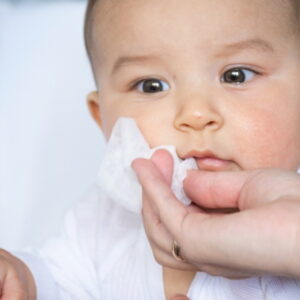If a baby has a red eye, what can it be and how should it be treated?
Here are different reasons for red eyes in babies and what to do about it.
Mom’s Question:
For the past week, my 8-month-old baby’s left eye has been red, or rather part of the eye is red. We went to the pediatrician, and he suggested Ciplox be applied, five drops a day for five days. We have applied it for two days. The redness is slightly reduced, but not that much.
What could this be?
Should we consult an ophthalmologist, or should we wait until after the full five days to see if it goes away?
Is there anything else we should do aside from applying the drops? Any suggestions would be greatly helpful.
Thanks in advance,
First time mom
Advice When Baby Has A Red Eye
There are several reasons why an infant may suddenly develop redness of one or both eyes. There may also be other symptoms that provide clues as to the cause. Here are some possibilities and advice on what to do next.
Scleral Hematoma
After a vaginal delivery, mothers may notice that their newborn has a bright red spot on the white portion of the eye. Such “red spots” may also appear when a baby has been vomiting because of a stomach virus. These areas of redness are known as scleral hematomas or subconjunctival hemorrhages. They are caused by bleeding or rupture of the tiny blood vessels within the sclera (white part) of the eye. These very fragile blood vessels are sensitive to even mild trauma, so scleral hematomas are quite common.
Despite their appearance, they are painless and have no effect on an infant’s vision. Over the course of two to three weeks, the blood is gradually reabsorbed into the bloodstream, and the eye once again appears normal. In most cases, scleral hematomas are only present in one eye. If both eyes are affected, this may indicate more significant trauma and an ophthalmologist should check the baby’s eyes.
Infection
A common reason for infants to develop eye redness is an infection, often called “pink eye.” In these situations, the sclera and inner eyelids are red, and mucous forms.
Bacterial eye infection
Bacterial eye infections may develop alone or as part of an upper respiratory infection. The most common cause is Haemophilis influenzae. Infants and children often develop an ear infection as well. Strep pneumoniae is a less common cause. Bacterial eye infections are easily spread from person to person, so diligent hand washing and isolation from others is important.
These infections are associated with a yellow or green discharge that appears in the corners of the eye throughout the day. A yellow “crust” may form on the eyelashes while a baby sleeps. The eyelids may also become swollen. Because of possible spread to other areas of the eye and to close contacts, these infections are treated with antibiotic drops. Antibiotic ointments may be prescribed for younger infants as it can be difficult to administer eyedrops, however, bacterial resistance is common.
There are sexually transmitted bacterial infections that can be transmitted from mothers to newborns during a vaginal delivery: Chlamydia trachomatis and Neisseria gonorrhea. Eye discharge and eyelid swelling develop during the first five days of life. Left untreated, these bacteria can spread to other areas of the body, causing pneumonia, sepsis, or meningitis.
Viral eye infection
Unlike bacterial types, viral eye infections are associated with a small amount of clear or cloudy discharge. Although this discharge less copious, it is very contagious. Adenovirus is the most common cause of viral “pink eye” with symptoms of fever, sore throat, cough, and congestion. Although the upper respiratory symptoms may linger, the eye redness self-resolves in two to three days. Antibiotic eye drops are ineffective.
Neonates may develop herpetic eye disease when born vaginally to mothers with this infection. In addition to eye redness, the resulting inflammation can cause scarring of the cornea and vision loss. Herpes viruses can spread to the baby’s bloodstream, resulting in sepsis or encephalitis.
Allergy
Allergy symptoms occur because of a predisposition to becoming sensitive to something in the environment. This sensitivity develops over time and after repeated exposures. Because of this, red eyes and other allergy symptoms typically do not appear until the toddler years. However, infants with a strong family history of seasonal allergies may develop eye redness, eyelid swelling, and tearing on “high pollen count” days. They may frequently rub their eyes because of the itching and occasionally sneeze.
In general, these infants typically do not experience the heavy nasal congestion and runny nose seen in older children. Eye symptoms may only last a day or two rather than weeks to months. Because of age restrictions and milder symptoms, antihistamines are typically not recommended for infants. In-home air filters, keeping windows closed, and avoiding time outdoors when allergen levels are high may reduce the frequency of eye symptoms.
Foreign Body or Debris
When something accidentally falls into a baby’s eye, it can cause immediate redness, tearing, and pain. It may be something as benign as an eyelash or serious as a particle of sand. In most cases, only one eye is affected.
What distinguishes this type of eye redness from others is the amount of discomfort. When something gets in the eye, it is important to take steps to minimize injury. Flushing the baby’s eye with lukewarm water or a sterile saline solution may wash away the source of irritation. If unable to remove it, medical attention is necessary. Some types of debris can scratch the cornea, and eye drops or ointment may be necessary to promote healing and prevent infection.
What to Do as a Parent
Based on the eyedrops prescribed, your baby likely has a bacterial eye infection. If any discharge was present before starting them, it should be nearly gone. After two days of using the eyedrops, her infection should be less contagious. It is now ok for her to be around other children and adults. However, it is best to continue a good hand-washing technique. If she has mild discomfort from eyelid swelling, cool compresses may help.
When Is a Follow-Up Visit Necessary?
After only two days of Ciplox, it is not unusual for your baby to still have some eye redness. However, if her symptoms are becoming worse or pain develops prior to day five, she should be seen again by her doctor. Worsening symptoms could be a sign of periorbital cellulitis, meaning the infection has spread to the deeper eye tissues.
If she develops a fever, her ears should be checked for a possible infection. After completing the five-day course of eyedrops, if the eye redness persists, call your doctor for a follow-up appointment. He or she will inform you of whether or not an ophthalmologist visit is necessary.
I hope this helps,
Paula
You can find some more discussion on babies with eye problems here:
(Answer approved by our Medical Reference Team)
Research References
- Doshi R, Noohani T. Subconjunctival Hemorrhage. [Updated 2023 Feb 20]. In: StatPearls [Internet]. Treasure Island (FL): StatPearls Publishing; 2023 Jan-.
- Pippin MM, Le JK. Bacterial Conjunctivitis. [Updated 2023 Jan 23]. In: StatPearls [Internet]. Treasure Island (FL): StatPearls Publishing; 2023 Jan-.
- CDC: Conjunctivitis (Pink Eye) in Newborns
- Northon Childrens: Signs of Allergies in Toddlers
- Domingo E, Moshirfar M, Zabbo CP. Corneal Abrasion. [Updated 2022 Jul 12]. In: StatPearls [Internet]. Treasure Island (FL): StatPearls Publishing; 2023 Jan-.
- Bae C, Bourget D. Periorbital Cellulitis. [Updated 2022 Jul 18]. In: StatPearls [Internet]. Treasure Island (FL): StatPearls Publishing; 2023 Jan-.
Find comments below.

Paula Dennholt founded Easy Baby Life in 2006 and has been a passionate parenting and pregnancy writer since then. Her parenting approach and writing are based on studies in cognitive-behavioral models and therapy for children and her experience as a mother and stepmother. Life as a parent has convinced her of how crucial it is to put relationships before rules. She strongly believes in positive parenting and a science-based approach.
Paula cooperates with a team of pediatricians who assist in reviewing and writing articles.







My daughter has been rubbing her left eye a lot lately and now it waters and she gets clod/sleep in her eye all the time. Only that eye. She also has a runny nose and a cough to match; kinda like she has a cold.
Should I take her to the hospital or should I not worry about it? Her eye also turned red for a couple of hours but went away n shes still rubbing her eye and it has stopped watery.
What to do and what may be the reason for your baby’s irritated eye, really depends on how long you mean by “lately”. If it’s been only a day, the reason might be a foreign object that got into her eye. To check for that – wash your hands and gently pull her lower lid down to see if there is anything in her eye. If there is, say, an eyelash stuck in there, do not remove it with your hands but try rinsing it out with lukewarm boiled water.
If your baby’s eye has been irritated for a few days, it may be a cold, and it is irritating her eye.
If it is a pink eye, she will have drainage coming from her eye, and it would stay red. She would also be irritable when she rubbed her eye because it feels similar to having sand in her eye.
Pink eye is a viral or bacterial infection of the eye and will not typically be associated with cough and a runny nose, although of course, they can come at the same time. But since the redness comes and goes and only when she rubs her eye, I really do believe the redness is due to the cold and the rubbing rather than to a pink eye infection. If the redness doesn’t disappear or you see pus in her eye, then she might have developed conjunctivitis (pink eye) due to spreading the virus to her eye.
Regarding her cold, it is usually not a reason to visit the doctor, unless it doesn’t go away within 7-10 days, or if she gets a very high fever, painful deep cough, breathing difficulty, or some other indication of more severe illness. Another reason would be if she is a newborn.
If she continues to have a runny nose, clod in her eye, and cough after 10 days then you need to see your pediatrician because she may have a sinus infection, which would require an antibiotic. If she starts to run a rectal temperature of 100.4 or higher, then take her to the doctor to be checked out.
If you feel something is just not right, then follow your instinct and take her to your pediatrician. I hope she starts to feel better.
Well, believe it or not, breast milk drops for pink eye, unreal how good this works. Our little girl @ the time was about 1 1\2 months old we tried all the Doctor meds; poor thing nothing worked. Yellow pus was steady coming out of her eye, so we read this on the net and gave it a shot. WOW, a drop every 4 hours. Sometimes we skipped because she was getting more irritated for trying to get her eye open but it really works cleared up in about 5 days we also had to gently push the pus out. It is easy to do and keep changing the cloth. Wash your hands every time you touch her eye.
Pink eye spreads easy. We got good @ it we found the best way was to use a syringe with the needle taken off and draw up a bit of milk and then just push out a drop while she had her eye open. I got my wife to talk to her from above her head so she would look up at her then plop right in. That worked well. You will miss but you will get better at it.
Don’t despair if her eye with the milk will get all crusty but that’s ok. When it is time for the next treatment, just wipe it off with a warm cloth and again try to push the pus out then clean it up and add the milk again.
And for baby thrush if your baby gets this, forget the Doctor meds, just use tincture of gentian violet. It will be gone in 3 to four days. She or he will have a dark purple mouth but it goes away. Just swab it with a q tip all in her cheeks and on the tongue where most of the problem is. You can get this stuff @ most health food stores.
Hope this helps you
Thanks a lot for your advice. We consulted an ophthalmologist and he said it was a minor allergy and suggested eye drops for ten days.Now she seems to be okay. For the past 6 days we have applied the drops, and we have to do it for four more days. The redness is slightly present, but I am confident that it will go away over the next few days.Thanks! :-)
which eye drop the opthalmologist suggested to you. Was that the same one u were using?